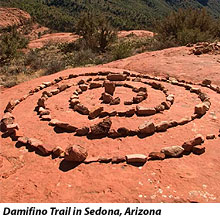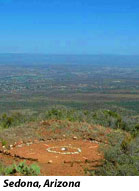 Medicine wheels or sacred hoops are stone structures constructed by the native peoples of North America and are believed to be used for various astronomical, ritual, healing, and teaching purposes. They were constructed by laying stones in a circular pattern that often looked like a wagon wheel lying on its side. The wheels could be large, reaching diameters of 75 feet.
Medicine wheels or sacred hoops are stone structures constructed by the native peoples of North America and are believed to be used for various astronomical, ritual, healing, and teaching purposes. They were constructed by laying stones in a circular pattern that often looked like a wagon wheel lying on its side. The wheels could be large, reaching diameters of 75 feet.
Almost all medicine wheels would have at least two of the three elements mentioned above (the center cairn, the outer ring, and the spokes), but beyond that there were many variations on this basic design, and every wheel found has been unique and has had its own style and eccentricities.
The most common deviation between different the wheels are the spokes. There is no set number of spokes for a medicine wheel to have. The spokes within each wheel are rarely evenly spaced out, or even all the same length. Some medicine wheels will have one particular spoke that’s significantly longer than the rest, suggesting something important about the direction it points.
Another variation is whether the spokes start from the center cairn and go out only to the outer ring, or whether they go past the outer ring, or whether they start at the outer ring and go out from there.
An odd variation sometimes found in medicine wheels is the presence of a passageway, or a doorway, in the circles. The outer ring of stones will be broken, and there will be a stone path leading up to the center of the wheel.
 Also many medicine wheels have various other circles around the outside of the wheel, sometimes attached to spokes or the outer ring, and sometimes just seemingly floating free of the main structure.
Also many medicine wheels have various other circles around the outside of the wheel, sometimes attached to spokes or the outer ring, and sometimes just seemingly floating free of the main structure.
They are made by placing rocks down into a circle shape, and four lines or more of rocks are put down across the circle, or near the circle. Medicine wheels are used to mark the geographical directions and astronomical events of the sun, moon, some stars, and some planets in relation to the Earth’s horizon at that location. These rock sites were also used for important ceremonies, teachings, and as sacred places to give thanks to the Creator, or Gitchi Manitou, known as the Great Spirit in the Ojibway native language. Other North American indigenous peoples also made these circle petroforms. Medicine wheels are very similar to circular turtle shaped petroforms with the legs, head, and tail pointing out the directions and aligned with astronomical events.
What is the meaning?
We will probably never know the original meaning of the medicine wheel. Archaeologists suspect that the function and meaning of the medicine wheel changed over time. Each medicine wheel has unique characteristics and qualities, challenging archeologists, to determine, with any precision, how each was used. Some have been dated to be over 4,500 years old.

The term “medicine wheel” was first applied to the Big Horn Medicine Wheel in Wyoming, the most southern one known. That site consists of a central cairn or rock pile surrounded by a circle of stone; lines of cobbles link the central cairn and the surrounding circle. The whole structure looks rather like a wagon wheel lain-out on the ground with the central cairn forming the hub, the radiating cobble lines the spokes, and the surrounding circle the rim. The “medicine” part of the name implies that it was of religious significance to Native peoples.
Perhaps one of the most interesting theories is that there are significant stellar alignments present at the medicine wheels. This theory was proposed by astronomer John Eddy. He suggested that a line drawn between the central cairn and an outlying cairn at the Bighorn Medicine Wheel pointed to within 1/3 of a degree of the rising point of the sun at the summer solstice. Other alignments, both to the summer solstice sunrise and to certain bright stars such as Aldebaran, Rigel or Sirius, have been proposed for a number of Alberta medicine wheels. The wheels would thus have functioned as a calendar to mark the longest day of the year. Presumably, such a calendar would be used for the timing of important rituals.
References:
Wikipedia – Medicine Wheel










